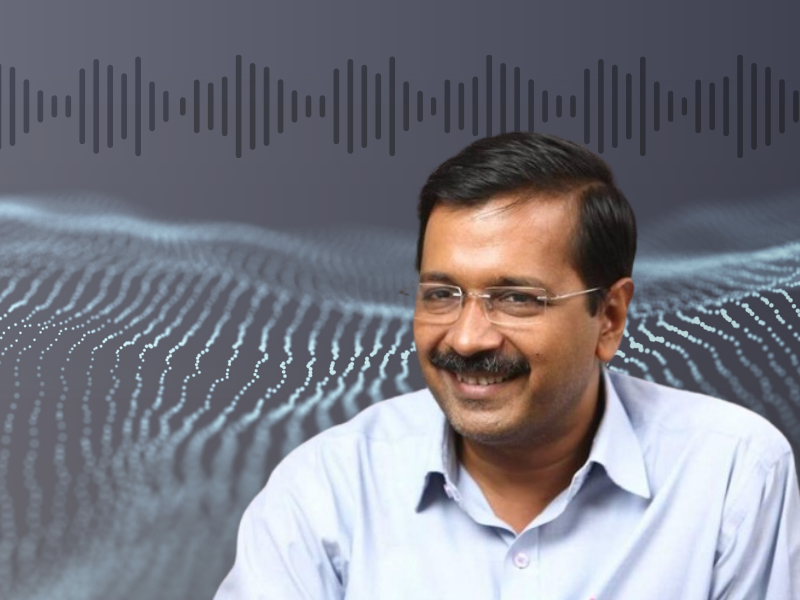By: umme kulsum
ankita kulkarni
March 26 2024
AAP leaders share AI-generated audio of Delhi CM Kejriwal's 'message from jail'

Representative image of Delhi CM Arvind Kejriwal. (Source: WikimediaCommons/ev.delhi.gov.in/Modified by Logically Facts)
Leaders and supporters of the Aam Aadmi Party (AAP) shared two AI-generated voice clones of Delhi Chief Minister Arvind Kejriwal's message on social media, drafted during his time in Enforcement Directorate (ED) custody.
This 'message from jail' emerged following Kejriwal's arrest by the ED in the Delhi liquor policy case. While the content of Kejriwal's message primarily criticizes the Bharatiya Janata Party (BJP), what garnered attention was the disclaimer accompanying each post shared by a party leader, indicating that the videos were generated using Artificial Intelligence (AI).
These two videos—one featuring the Delhi Chief Minister speaking in Hindi (archived here) and the other in English (archived here)—feature a voice remarkably similar to Kejriwal’s. In these recordings, Kejriwal asserts that no prison could 'confine him for long.' He calls for unity to restore India's greatness, denouncing both internal and external forces that undermine the nation. Additional archived versions of similar posts shared by AAP leaders can be viewed here, here, and here.
The videos gained traction following the arrest of Kejriwal, who is also the National convener of AAP, from his residence by ED on March 21, 2024, in connection with a money-laundering case related to an alleged liquor policy scam. Kejriwal reportedly received nine summonses from the investigative agency to comply and participate in the probe; however, his refusal led to his arrest.
Subsequently, on March 23, his wife, Sunita Kejriwal, relayed a message from Kejriwal during a virtual press conference. Quoting his words, she said, “My dear countrymen, I have been arrested. Whether I am inside the jail or not, I will continue to serve the country. My entire life is dedicated to the country. I have struggled a lot in my life, and I know that this will continue. Therefore, this arrest has not surprised me."
Upon analysis of both videos—one featuring Sunita Kejriwal reading her husband’s message and the other the viral clip—it was discovered that the message in both videos is identical, confirming that the video clip with Kejriwal’s voice is generated using AI. Notably, the audio tone is neutral and monotonic, lacking modulation in tone, pitch, or volume.
Experts highlight anomalies
Tanmay Srivastava, a forensic audio expert, pointed out, "Both audio clips appear to have been generated by AI. In the Hindi clip, the discernible breathing pauses around 0.07-0.08 suggest realism, possibly achieved through a Retrieval-based Voice Conversion AI model. Additionally, the absence of background noise and the presence of a distinct clicking sound at 0.01 imply high-quality recording conditions, unlikely in a prison (uncontrolled) setting. Moreover, the mechanical tone of the word 'humare' at 0.17-0.18 is characteristic of AI-generated speech."
The English clip, he said, exhibits clearer signs of artificial generation. "The unnatural pauses, like the one at 0.04-0.05 after 'all my life,' likely result from noise-gate filtering. Towards the end, elongated words and shaky patterns after the 0.28 timestamp deviates from natural speech."
Furthermore, we used itisaar.ai, a deepfake detection tool developed by professors from the Indian Institute of Technology, Jodhpur which, too, identified both the clips as AI-generated.
How to spot deepfakes?
To identify deepfakes, or AI-generated images and videos, one should look for inconsistencies such as mismatched lip movements, unnatural audio tones, distorted hand and toe positions in images, or unusual vehicle and tree structures. A detailed guide can be found here.
Similar AI-generated videos and deepfakes have previously gone viral and been debunked; related articles can be accessed here, here, and here. Logically Facts has also published a comprehensive report on the role of AI in the 2024 Indian elections (read here) and the emergence of deepfakes in India (read here).
Arvind Kejriwal and New Delhi Excise Policy
In November 2021, the Delhi government implemented an Excise Policy aimed at transforming the liquor retail sector in the national capital with the objectives of increasing state revenue and addressing the sale of counterfeit alcohol. However, in 2022, the policy was rescinded due to purported irregularities in its implementation, prompting the Delhi government to initiate a CBI investigation.
In August 2022, the Central Bureau of Investigation (CBI) conducted raids targeting the then Deputy Chief Minister Manish Sisodia, alleging his involvement in the excise policy scandal. Subsequently, the ED claimed that Kejriwal himself had connections with key individuals implicated in the case.
AI as an election campaigning tool
This isn't a new or isolated occurrence. Just before the elections in neighboring Pakistan, a deepfake audio featuring jailed leader Imran Khan surfaced on social media, purportedly urging people to boycott the polls. A Logically Facts analysis revealed the audio to be fake, shared to deceive voters.
Kejriwal's video is yet another instance of a prominent leader's deepfake being circulated by political parties as a campaigning tool in the lead-up to the 2024 Lok Sabha elections. Not long ago, the official account of the Indian National Congress shared a deepfake video of Prime Minister Narendra Modi (archived here), digitally placing his face on the body of the singer Justh, who had recently released a viral song titled 'Chor (Thief)'. The voice was also manipulated using AI tools to simulate Modi singing the song.


